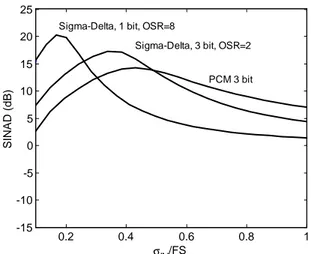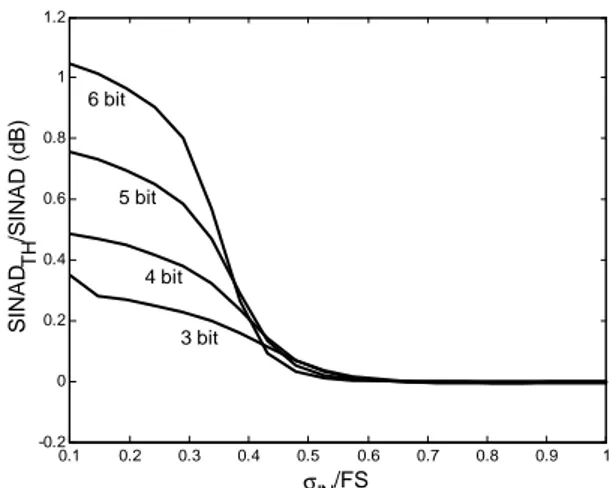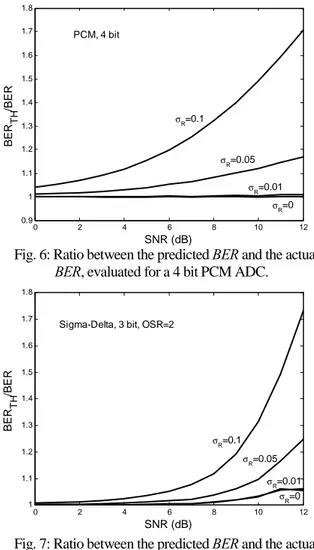UNIVERSITY
OF TRENTO
DEPARTMENT OF INFORMATION AND COMMUNICATION TECHNOLOGY
38050 Povo – Trento (Italy), Via Sommarive 14
http://www.dit.unitn.it
EFFECTS OF ADC INTEGRAL NON-LINEARITY ON DIGITAL
TRANSMISSION
Antonio Moschitta, Dario Petri
February 2004
Fig. 1: SINAD performance of PCM and Σ∆ converters 0.2 0.4 0.6 0.8 1 -15 -10 -5 0 5 10 15 20 25 σIN/FS SI N A D (dB) PCM 3 bit Sigma-Delta, 3 bit, OSR=2 Sigma-Delta, 1 bit, OSR=8
Effects of ADC Integral Non-Linearity on Digital Transmission
Antonio Moschitta
1, Dario Petri
21Università degli Studi di Perugia, Dipartimento di Ingegneria Elettronica e dell’Informazione Phone: ++39-075-585-3933, Fax: ++39-075-585-3654, Email: [email protected]
2Università degli Studi di Trento, Dipartimento di Informatica e Telecomunicazioni Phone: ++39 0461 883902, Fax: ++39 0461 882093, Email: [email protected] Abstract: This paper investigates the effects of Integral Non-
Linearity (INL) on the performances of both A/D converters and Digital Communication Systems, which exploit Direct Digital Modulation. The performances of both PCM and Sigma-Delta converters affected by INL are considered and compared. Then, the effects of INL upon the BER performances of an OFDM system are evaluated and modeled. The accuracy of the theoretical model is discussed with respect to the ADC resolution and INL levels. It is shown that a multibit Sigma-Delta converter, operating at a low oversampling ratio, may outperform PCM converters. Keywords: OFDM, Integral Non-Linearity, Sigma-Delta
I.
I
NTRODUCTIONDirect Digital Modulation (DDM) techniques, based upon A/D and D/A conversion of the modulated waveforms, are commonly used to implement modern Digital Communication Systems (DCS), achieving improved performances with respect to analog modulation schemes [1]. DDM also allows shifting signal-processing functions into the digital domain, thus obtaining more accurate and reproducible performances at a cost of more severe requirements for the involved A/D and D/A converters. Consequently, ADC and DAC unidealities may noticeably influence the overall system performance. It should be noticed that many DCSs, like Orthogonal Frequency Division Multiplexing (OFDM) systems or the downlink of Universal Mobile Telecommunication Systems (UMTS) [2], produce Gaussian distributed signals. In particular, OFDM is a multicarrier technique, adopted for several standards, like DVB-T [3], DAB [4], and ADSL [5], whose signals show a flat spectrum in the useful signal bandwidth [1]. Thus, characterizing the behavior of an A/D converter by means of Gaussian distributed testing signals may provide more useful results than the ones provided by a traditional sine wave test.
This paper analyzes the effects of Integral Non-Linearity (INL) upon the overall Bit Error Rate (BER) performance of
an OFDM DCS. Both PCM and Sigma-Delta (Σ∆)
converters are considered, and their performances are compared. Particular attention is given to multibit Σ∆s operating at a low oversampling ratio (OSR). In fact, in a wideband DCS, high OSRs may require an exceedingly high sampling rate. At first, the ADCs are considered as standalone components, and the effect of INL upon the output Signal to Noise and Distortion Ratio (SINAD) is analyzed. It is shown that a b-bit Σ∆ converter is more
robust to INL than a b-bit PCM, while offering at the same time a better effective resolution. Then, the A/D converters are considered as a part of an OFDM receiver, and the influence of the ADC INL upon the OFDM BER performance is investigated. The performance requirements of A/D converters employed in OFDM systems have been evaluated in previous works [6]. Due to the high computational costs of low BER simulations, in this paper have been considered lower ADC resolutions. However, it has been verified that the presented results hold also for higher resolution ADCs. The BER analysis shows that DCSs robustness to ADC INL may depend not only on the ADC topology, but also on the DCS characteristics.
II. E
FFECTS OFI
NTEGRALN
ON-L
INEARITY ONADC
PERFORMANCE
Fig. 1 shows the SINAD behavior of a PCM and two first order loop Σ∆ band-pass converters, fed with a white Gaussian distributed signal. The converters are assumed ideal, and SINAD is reported as a function of the input signal standard deviation σIN normalized to the ADC Full Scale FS. For Σ∆ converters, FS is related to the internal PCM. As the ADC stimulus is a wideband Gaussian noise, the SINAD cannot easily be evaluated by means of a Fourier analysis, usually performed when the input testing signal is a sine wave [7]. Thus, a time-domain approach has been adopted, that is based on the evaluation of the power of the quantizer error sequence. Each curve in Fig. 1 has a maximum, resulting from a tradeoff between granular noise, which
grows with the ADC FS, and overload noise, which grows with the input signal dynamic range. Notice that the curve related to the PCM converter has been theoretically modeled [8]. It can be seen that, when optimal matching between input signal and ADC dynamic range is achieved, a 3-bit Σ∆ converter operating at OSR=2 provides a better SINAD than a 3-bit PCM. However, when overload is introduced, the SINAD of the 3-bit Σ∆ decreases faster than the 3-bit PCM one. Such a behavior is related to the feedback nature of Σ∆ converters, which may suffer overload even for amplitude limited input signals. The single-bit Σ∆ ADC operating at OSR=8 achieves a higher peak SINAD, but it shows an even higher sensitivity to overloading effects. Moreover, it can be seen that when the σIN/FS ratio deviates from the optimal value, the single-bit Σ∆ SINAD performance deteriorates faster than the 3-bit Σ∆ and PCM converters. As in a real transmission channel the ADC input signal dynamic range may vary quickly due to multipath and fading phenomena [9], it results that multibit ADCs are potentially a better solution for implementing a DDM based DCS receiver. In Fig. 2, the ratio between the SINAD of ideal ADCs and the SINAD of ADCs affected by INL is reported in dB as a function of σIN/FS, thus providing information on the performance reduction caused by INL. The quantizer has been modeled as a flash converter, and its resistors deviate from a nominal unit value by a Gaussian distributed offset, whose standard deviation σR equals 10% of the nominal resistance. Such a value, corresponding to large INL values, has been introduced to perform a worst-case analysis. It can
be noticed how the 3-bit Σ∆ ADC shows a lesser
performance degradation than the PCM converters. In fact, due to the Σ∆ feedback topology, small variations in the characteristics of the internal quantizer, which is located on the forward branch, do not have a great influence on the ADC performances. Moreover, due to the oversampling and noise shaping features, Σ∆ converters exhibit a greater accuracy with a lower quantizer resolution, that is, with less INL contributors.
III. E
FFECTS OFADC
I
NTEGRALN
ON-L
INEARITY ONOFDM
SYSTEMBER
In order to analyze the effects of ADC INL on the performances of a DCS, an OFDM system, similar to a DVB-T system operating in 2k-mode, has been considered [1],[3],[6]. Such a system uses 2048 QPSK modulated carriers, of which only 1705 are active [3]. Moreover, an Additive White Gaussian Noise (AWGN) transmission channel has been modeled.
Fig. 3 shows the system performance expressed in terms of BER, using both PCM and Σ∆ converters based on an ideal quantizer, as a function of Signal to Channel Noise Ratio (SNR). The results in Fig. 3 are obtained by optimally matching the ADC dynamic range to the standard deviation of its input signal, which is the sum of useful signal and channel noise, according to the results presented in Fig.1.
Notice that, as signal and channel noise are uncorrelated, the ADC input power is the sum of the useful signal power and the AWGN power. In particular, Fig.3 shows that that the 3-bit Σ∆ ADC provides better performances than the 3-bit PCM one, and closely matches the performances of a 4-bit PCM ADC.
Fig. 4: BER worsening caused by ADC INL, for both PCM and Σ∆ ADC, σR=0.1.
Fig. 3: BER vs. SNR, for ideal PCM and Σ∆ ADC. Fig. 2: SINAD worsening caused by ADC INL σR=0.1.
0.1 0.2 0.3 0.4 0.5 0.6 0.7 0.8 0.9 1 0 0.2 0.4 0.6 0.8 1 1.2 1.4 1.6 1.8 σIN/FS SI N A D ID /S IN A D IN L (d B )
Sigma-Delta, 3 bit, OSR=2 PCM, 3 bit PCM, 4 bit 0 2 4 6 8 10 12 10-5 10-4 10-3 10-2 10-1 100 BE R SNR (dB) PCM, 4 bit PCM, 3 bit Sigma-Delta, 3 bit, OSR=2
0 2 4 6 8 10 12 1 1.02 1.04 1.06 1.08 1.1 1.12 1.14 1.16 1.18 SNR (dB) BER IN L /BE R ID Sigma-Delta, 3 bit PCM, 3 bit
The loss of performance caused by quantizer INL is analyzed in Fig. 4 as a function of SNR. By comparing the BER variation of both PCM and Σ∆ ADCs, it can be observed that the 3-bit Σ∆ converter provides a slightly less robust performance to INL than the 3-bit PCM. Such a behavior may be explained with the interaction between the feedback topology of the Σ∆ converters and the non-linear features of the internal PCM, which introduce intermodulation noise in the useful signal bandwidth [1]. A similar phenomenon has been described in [1] and [9] in order to motivate the influence of Σ∆ ADC overload error on the BER performance of an OFDM receiver.
The effect of INL on the performance of the considered OFDM system has been modeled by assuming that the statistical properties of quantization noise do not significantly change when a moderate amount of INL is introduced. By generalizing the results reported in [1], under the hypothesis that quantization noise is white even in presence of ADC non-idealities, for a PCM conversion we obtain: + = − 2 1 1 2 1 A SNR N n N erfc BER A B , (1) ) / ( 1 1 1 FS SINAD SNR A IN σ + = ,
where erfc() is the complementary error function, N is the number of OFDM carriers, NA is the number of active carriers, and nB is the number of bits transmitted by a single carrier in an OFDM symbol, which for QPSK modulations equals 2 [10]. The parameter SINAD(σIN/FS) can be derived from Figs. 1 and 2 for a given value of σIN/FS. Equation (1) can be extended to Σ∆ converters, by keeping into account the noise-shaping feature. In fact, the overall BER may be obtained by averaging the BER of the OFDM carriers [1]. By assuming that the internal quantizer generates a white noise, the BER of the i-th carrier may be expressed by the following relationship: + = − 2 1 2 | ) ( | 1 2 1 H A SNR N n N erfc BER A B N i i αω , (2)
where HN(ω) is the Σ∆ noise transfer function, ωi is the frequency of the i-th OFDM carrier, and α is the ratio between the in-band quantization noise power of the Σ∆ ADC and the quantization noise power of the Σ∆ internal quantizer. By defining α as:
∫
= BW N d H ω ω π α 2 | ) ( | 2 1 , (3)where BW is the double sided signal bandwidth, the quantization noise contribution to BER is expressed as a function of the Σ∆ SINAD.
It should also be noticed that for an A/D converter operating in its granular region, INL effects on SINAD might be theoretically estimated. In fact, according to [7], the quantization noise power of a PCM converter affected by INL may be approximately expressed as
∑
= + = M k k q q M inl 1 2 2 0 2 σ 1 σ , (4)where σq20is the quantization noise power of an ideal PCM converter, M is the number of quantizer thresholds and inlk is the displacement of the k-th quantizer threshold due to INL. As (4) expresses the INL contribution to overall quantization noise power in a simple closed form, it is possible to estimate the SINAD variation induced by INL. It should be noticed that (4) has been derived in [7] under the assumption of uniformly distributed ADC input signal, and consequently it does not provide exact results when Gaussian distributed ADC stimuli are considered. In particular, it has been verified by means of meaningful simulations that such an approach introduces an error on the SINAD estimate which grows with the PCM resolution, exceeding 1 dB for a 6 bit flash PCM when σR=0.1. Fig. 5 reports the ratio between the SINAD obtained by applying Eq. (4) to the flash PCM described in section II and the SINAD obtained throughout simulations, expressed in dB as a function of σIN/FS. It is worth of notice that for an high σIN/FS, that is when deep overloading is introduced, INL does not affect anymore the ADC performances, and the reported curves show the same asymptotic behavior. It can be seen that, for the considered 3-bit and 4-bit flash PCM, the SINAD error introduced is negligible. Thus, by substituting the SINAD estimate in (1) and (2), it is possible to estimate the INL effects on the
Fig. 5: SINAD estimation error introduced by applying Eq. (4) to a PCM affected by INL (σR=0.1), fed with a Gaussian distributed input signal.
0.1 0.2 0.3 0.4 0.5 0.6 0.7 0.8 0.9 1 -0.2 0 0.2 0.4 0.6 0.8 1 1.2 σIN/FS SIN A D TH /S IN AD (d B) 3 bit 4 bit 5 bit 6 bit
system BER. Fig. 6 and 7, obtained for a 4 bit PCM and a 3 bit Σ∆ converter respectively, report the ratio between the BER estimate provided by (1)-(2) and the BER evaluated by means of simulations, as a function of the SNR. Various curves are reported, obtained for different levels of INL, that is for different values of σR. It can be noticed that the theoretical model overestimates the actual BER when large INL values are introduced. In fact, when INL is present, quantization error is no more a zero mean sequence. Consequently, a not negligible fraction of the overall quantization error power may be located on the DC component in the quantization error power spectrum. As the considered OFDM system performs bandpass A/D conversion, the DC component of quantization error is removed by the bandpass quantization noise filter. Thus, only a fraction of the quantization noise power introduced by INL actually affects the BER performances. This effect, as shown in Figs. 6-7, is more pronounced for high SNR, that is when quantization noise is dominant with respect to channel noise. It has also been verified that the accuracy of (1) and (2) is improved when higher ADC resolution are used, both for PCM and Σ∆ converters.
IV.
C
ONCLUSIONSThe effects of INL upon the performance of ADCs and of an OFDM DCS exploiting DDM have been considered, showing that Sigma-Delta converters are more robust to INL than PCM ones. In particular, it is shown that a multibit Sigma-Delta ADC operating at a low OSR may outperform a PCM of the same resolution with respect to SINAD and BER performances. However, the robustness of the DCS to ADC INL may depend on both the ADC and DCS architectures. Consequently, a SINAD analysis alone may not conveniently describe the influence of A/D conversion on the performance of a DCS. An approximated theoretical model has been introduced, which conveniently describes the effects of INL upon both SINAD and BER performances, and its accuracy has been evaluated. Future developments are a more accurate modeling of the effects of INL and the extension of the analysis to other DCSs.
R
EFERENCES[1] A. Moschitta, D. Petri, “Analysis of Bandpass Sigma-Delta conversion in OFDM Systems,” proc. of the 8th IEEE Int. Conf. on Electronics, Circuits and Systems, Malta, 2-5 September 2001, pp 1387-1390.
[2] H. Holma and A.Toskala, WCDMA for UMTS, John Wiley & Sons, 2001.
[3] ETS 300 744, “Digital Video Broadcasting (DVB); Framing structure, channel coding and modulation for digital Terrestrial television (DVB-T),” available on the Internet at www.etsi.org.
[4] ETS 300 401, “Radio Broadcasting systems; Digital audio Broadcasting (DAB) to mobile, portable and
fixed receivers,” available on the Internet at
www.etsi.org.
[5] ANSI T1.413, “Asymmetric Digital Subscriber Line (ADSL) Metallic Interface,” 1995.
[6] A. Moschitta, D. Petri, “Performance Requirements of Bandpass Sigma-Delta Converters in OFDM Systems,” proc. of 6th Euro Workshop on ADC Modelling and Testing, Lisbon, Portugal, 13-14 September 2001, pp. 125-129.
[7] P. Carbone, D. Petri, “Noise Sensitivity of the ADC Histogram Test,” IEEE Trans. Instrumentation and Measurements, vol. 47, no. 4, August 1998.
[8] F.H. Irons, K.J.Riley, D. M. Hummels, G. A. Friel, “The Noise Power Ratio,” IEEE Trans. Instrumentation and Measurement, vol. 49, no. 3, June 1999.
[9] J. G. Proakis, Digital Communications, Mc. Graw Hill, 1983.
[10] A. Moschitta, D. Petri, “Wideband Communication System Sensitivity to Quantization Noise,” accepted for presentation at the IMTC 2002 conference, to be held in Anchorage, AK, USA, 21-23 May 2002.
Fig. 6: Ratio between the predicted BER and the actual BER, evaluated for a 4 bit PCM ADC.
Fig. 7: Ratio between the predicted BER and the actual BER, evaluated for a 3 bit Σ∆ converter, OSR=2.
0 2 4 6 8 10 12 0.9 1 1.1 1.2 1.3 1.4 1.5 1.6 1.7 1.8 SNR (dB) BER TH /B ER PCM, 4 bit σ R=0.1 σ R=0.05 σR=0.01 σR=0 0 2 4 6 8 10 12 1 1.1 1.2 1.3 1.4 1.5 1.6 1.7 1.8 SNR (dB) BER TH /B ER σR=0.1 σR=0.05 σR=0.01 σR=0 Sigma-Delta, 3 bit, OSR=2



